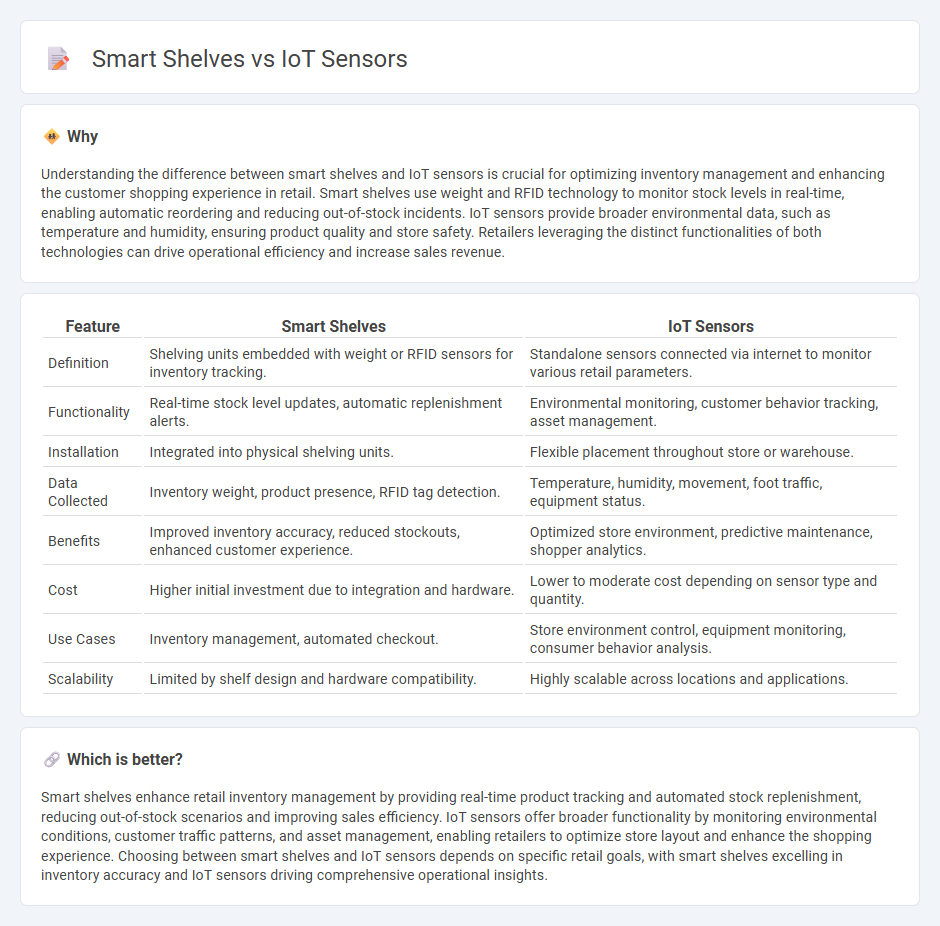
Smart shelves utilize embedded weight sensors and RFID tags to monitor inventory levels in real time, enhancing stock accuracy and reducing out-of-stock incidents. IoT sensors extend this capability by connecting various store elements like temperature, humidity, and movement detection, enabling comprehensive environmental and operational insights. Explore the advantages of smart shelves and IoT sensors for transforming retail management and customer experience.
Why it is important
Understanding the difference between smart shelves and IoT sensors is crucial for optimizing inventory management and enhancing the customer shopping experience in retail. Smart shelves use weight and RFID technology to monitor stock levels in real-time, enabling automatic reordering and reducing out-of-stock incidents. IoT sensors provide broader environmental data, such as temperature and humidity, ensuring product quality and store safety. Retailers leveraging the distinct functionalities of both technologies can drive operational efficiency and increase sales revenue.
Comparison Table
| Feature | Smart Shelves | IoT Sensors |
|---|---|---|
| Definition | Shelving units embedded with weight or RFID sensors for inventory tracking. | Standalone sensors connected via internet to monitor various retail parameters. |
| Functionality | Real-time stock level updates, automatic replenishment alerts. | Environmental monitoring, customer behavior tracking, asset management. |
| Installation | Integrated into physical shelving units. | Flexible placement throughout store or warehouse. |
| Data Collected | Inventory weight, product presence, RFID tag detection. | Temperature, humidity, movement, foot traffic, equipment status. |
| Benefits | Improved inventory accuracy, reduced stockouts, enhanced customer experience. | Optimized store environment, predictive maintenance, shopper analytics. |
| Cost | Higher initial investment due to integration and hardware. | Lower to moderate cost depending on sensor type and quantity. |
| Use Cases | Inventory management, automated checkout. | Store environment control, equipment monitoring, consumer behavior analysis. |
| Scalability | Limited by shelf design and hardware compatibility. | Highly scalable across locations and applications. |
Which is better?
Smart shelves enhance retail inventory management by providing real-time product tracking and automated stock replenishment, reducing out-of-stock scenarios and improving sales efficiency. IoT sensors offer broader functionality by monitoring environmental conditions, customer traffic patterns, and asset management, enabling retailers to optimize store layout and enhance the shopping experience. Choosing between smart shelves and IoT sensors depends on specific retail goals, with smart shelves excelling in inventory accuracy and IoT sensors driving comprehensive operational insights.
Connection
Smart shelves in retail utilize IoT sensors to monitor inventory levels in real-time, enabling automatic restocking alerts and reducing stockouts. These sensors collect data on product weight, placement, and customer interactions, optimizing supply chain efficiency and enhancing customer experience. Integration of smart shelves with IoT platforms allows retailers to analyze shopping patterns and improve store layout strategically.
Key Terms
Real-time Inventory Tracking
IoT sensors provide real-time inventory tracking by continuously monitoring stock levels, temperature, and movement, enabling precise data collection and instant alerts for restocking. Smart shelves use embedded weight sensors and RFID technology to detect product presence and quantity, offering automated inventory updates and minimizing human error in retail environments. Discover how integrating IoT sensors and smart shelves can revolutionize your inventory management efficiency.
Automated Stock Replenishment
IoT sensors continuously monitor inventory levels, detecting real-time product depletion with high accuracy to trigger automated stock replenishment systems. Smart shelves equipped with weight sensors and RFID technology provide immediate data on product availability and customer interactions, enabling precise restocking without manual checks. Explore the latest advancements in automated stock replenishment to optimize retail efficiency and reduce out-of-stock incidents.
Shelf Analytics
IoT sensors embedded in retail environments collect real-time data on customer interactions, enabling precise shelf analytics that optimize inventory management and product placement. Smart shelves utilize weight sensors and RFID technology to monitor stock levels and detect missing items instantly, reducing out-of-stock situations and improving sales efficiency. Explore how combining IoT sensors with smart shelves can revolutionize shelf analytics and boost retail performance.
Source and External Links
Top 10 IoT Sensor Types, Use Cases, and Examples - IoT sensors are physical devices that collect environmental data like temperature, humidity, motion, and light, then transmit it to connected systems over the internet for smart, automated decision-making across industries such as agriculture, healthcare, and smart cities.
16 Types of IoT Sensors - IoT sensors, including accelerometers, air quality monitors, cameras, and chemical sensors, are embedded in everyday devices to gather real-time data--such as temperature, traffic, or health metrics--and send this information to the cloud for remote monitoring and analysis.
16 Types of sensors used in IoT - IoT sensors are electronic modules that detect ambient or system conditions (e.g., temperature, air quality) and transmit data via networks to gateways and the cloud, where it can be analyzed for actions, cost savings, or safety improvements.
 dowidth.com
dowidth.com